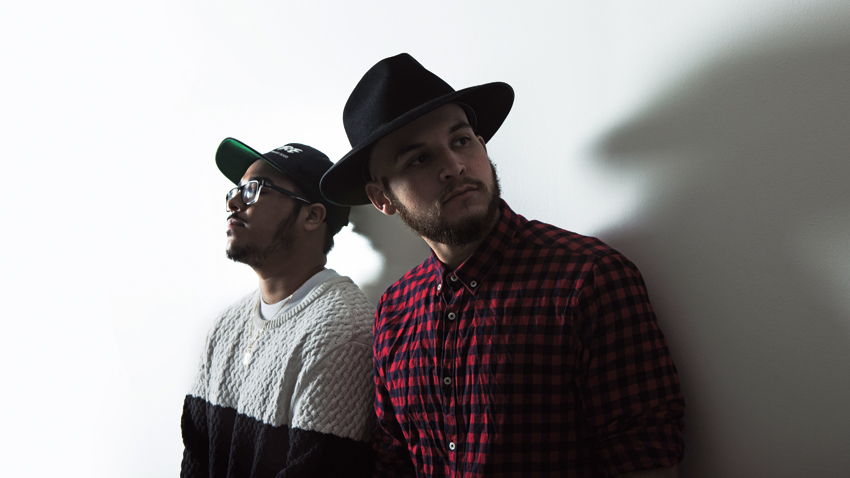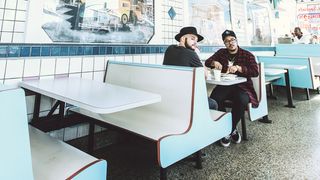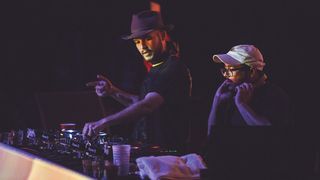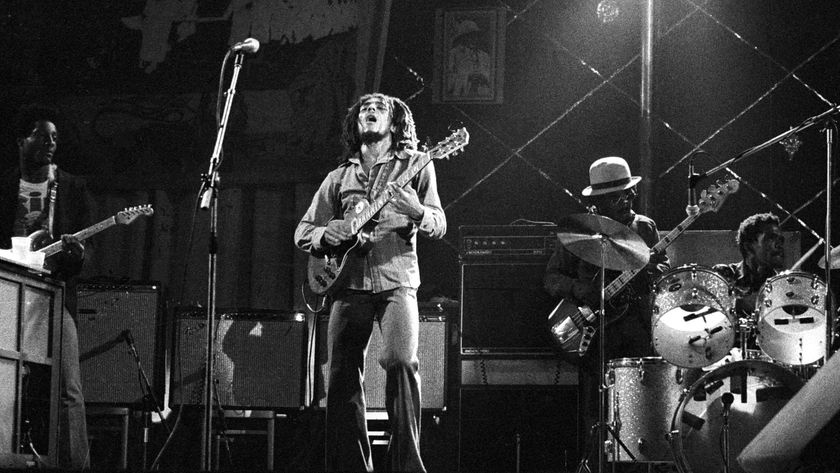GTA on finding their sound and producing their debut album
The genre-flippin' Miami duo reckon that their success is down to trial and error... and free synths from Computer Music magazine!

Miami's connection with dance music goes back a long way. For over 30 years, the gaudily glamorous city has been welcoming DJs, producers, promoters and labels to the annual Winter Music Conference, spawning equally important industry get-togethers like The Producer's Forum and the Ultra Music Festival.
Many would argue, though, that Miami's geographical and cultural association with Cuba injected rhythm into the city's bloodstream way before the WMC - two or three hundred years ago! Take an evening stroll downtown and you'll hear it: the patter of rhythm and sultry melodies that provides Miami's constant soundtrack.
It's no surprise, then, that Miami-born-and-raised Matt Van Toth and Julio Mejia - aka GTA, which stands for Good Times Ahead, just in case you're reading this while sat at your Xbox - ended up making music.
"I grew up with dance music," remembers Van Toth. "It was everywhere. But I was under 21, so I didn't have access to anything like the Ultra Music Festival, because they wouldn't let me in the clubs. My first real experience was warehouse raves… hearing this music and wondering, 'How the hell did they make that?'
Eventually hooking up with Mejia, the duo's skewed anthems soon grabbed the attention of Rihanna and Calvin Harris, who both took GTA out on tour. You can guess the rest of the story… Coachella, Electric Daisy Carnival, remixes for the likes of Kylie Minogue and deadmau5, remixed by Skrillex and a worldwide hit with Martin Solveig, Intoxicated.
Time has been understandably tight for Van Toth and Mejia, but they've finally finished work on their debut album, also called Good Times Ahead. We caught up with them on a rare off-day, chillin' in Miami.

There's been talk of a GTA album for a couple of years now. What took you so long?
Get the MusicRadar Newsletter
Want all the hottest music and gear news, reviews, deals, features and more, direct to your inbox? Sign up here.
Julio Mejia: "Generally speaking, dance music is about singles. You have one song that has one message, and that's all you have to worry about. With an album, you're suddenly confronted with a whole collection of songs - different songs with different ideas - but you have to find some way to make all those songs fit together. We thought that would be pretty easy… after all, these are our songs… but once we really go into it, we realised we had no idea what we were doing."
Matt Van Toth: "I'll be honest with you and say that we made a lot of music over the last couple of years that we knew was never going to fit on the album. I guess what we ended up doing was looking at everything and deciding which tracks were going to work.
"Time has also been a problem. We do over 200 shows a year and it's not easy to start thinking about which track will open the album when you've just come off stage at three in the morning and you're still jet lagged. We wanted to take our time with the album… we wanted to get it right."
Presumably, one of the problems is that you've never relied on a tried-and-trusted formula. For better or worse, it does happen a lot: an artist will chance upon a hit formula, and every track follows the same pattern. This isn't meant to sound like a criticism, but there often seems to be an almost random element to GTA songs… as if they got made by mistake. Ideas and noises - ones that shouldn't work - somehow seem to make sense.
JM: "We don't consider that criticism at all. When we first met, we didn't really know what kind of songs we wanted to make… there was no, 'Let's make this kind of track'. We wanted it to be energetic and clubby, but we talked about everything from beats and pop to house tracks and festival tunes. We just wanted to make music and do whatever we felt like doing. No rules, nothing like that."
MVT: "A lot of what we do is trial and error. We throw shit together and accidents happen. Wow! That sounds awesome. What the hell did we do there? If I think back to when we first met, we were both inspired by electro/Dutch house. I remember playing a lot of Afrojack, Sandro Silva, Chuckie and the whole Dirty Dutch crew. But we loved listening to tons of other stuff like trance, rap, rock and bass music… Rusko, Caspa, Excision, Noisia and Netsky. But we'd take all of those influences and try to mess them up.
"Every time we opened up a plugin, we'd be looking for the weirdest, oddest sounds, and then we'd mess it up and mess it up until we found something that we'd never heard before. That's when music gets really exciting - when you're off into unknown territory.
"Obviously, you do have to learn some of the basic stuff, too. One of the first tracks that really blew me away was Benni Benassi's Satisfaction. I spent ages trying to recreate that song… working out what makes a great bassline, a great drop, a great build-up. Why does this snare work and that snare doesn't?
"In those early days, we made tons and tons of music that never got released - it was just us finding out what we wanted to sound like. No… it wasn't what we 'wanted' to sound like; it was finding out what worked and what made us excited."
A lot of what we do is trial and error. We throw shit together and accidents happen. Wow! That sounds awesome. What the hell did we do there?
A lot of readers will have been in that same position. You put on your favourite tune, try to recreate that killer build-up and… it never sounds as good, does it?
MVT: "Almost every other producer we've talked to has told us that story. Right at the beginning, you're not really sure what you're after, so you throw everything into the song and, bit by bit, you learn what EQ works for you and your preferred technique for sidechaining. You're stumbling through the undergrowth and, one day, you realise that the sound you've just created feels right. Not because you've used this synth or this reverb, but because it resonates with you. It makes sense to you."
What platform were you working on in the early days?
JM: "Before I met Matt, my musical world was based very much in traditional instruments. My mom enrolled me in the trumpet class at school, which doesn't sound particularly cool, but it meant I was suddenly exposed to all the different kinds of music you can find in Miami. It was a real melting pot of styles and I got fascinated by the idea of improvising over the top of these different grooves.
"Somewhere along the way, I got introduced to FruityLoops and kind of went a bit crazy because the computer suddenly allowed me to go anywhere. All these mad improvisations that I had in my head could be turned into music. I might not be able to play them 'physically', but the computer turned me into a super-musician. I could play anything I wanted."
MVT: "FruityLoops was the thing that kind of brought us together. I started out on Sonar, then investigated Ableton and then ended up with FruityLoops. Julio was out on Facebook trying to pick up a few tips about FruityLoops and we got introduced through a mutual friend."
It's always good to come across a producer who isn't using Ableton Live or Logic. Adds a bit of variety to life!
MVT: "We do use Ableton, too."
Darn it!
MVT: "FruityLoops - I guess I should call it FL Studio - is definitely the main tool, though. There's just something about the workflow that makes total sense to me… your song is there, at your fingertips. Yes, there are a lot of similarities between DAWs, but the piano roll and the sequencer seem to have this unique feel.
"You can bring in an obvious sound, totally mess it up, throw it into the sequencer, start working anywhere you want in the session… I guess what I'm trying to say is that it never makes me think that I have to work in a certain way. It puts everything in front of you and says, 'You decide where you want to go'. That might sound confusing, but it's not. It feels totally intuitive and allows you to get things done.
"One thing you can definitely say about FL is that you hardly ever waste time thinking, 'How do I do this?' Maybe that's why people who do use it really fall in love with it. It allows you to get more out of a day in the studio."
Are you working out of a 'studio', or is it a bedroom-special?
MVT: "Ha ha! Yeah, the studio is at my house. I use a Razer PC and I love it! I'm actually about to order the new one that just came out with updated hardware. They recently had a promotion with Image-Line and I think you get FL when you buy their laptops. The computers themselves run very well and the warranty is excellent! Highly recommended to anyone in the market for a powerful PC laptop.
"All we've got in the studio is the computer, monitors, a MIDI keyboard and a Moog Little Phatty. Personally, I can't see the point of us having a ton of hardware, because we'd never get round to actually using it; we're hardly ever here. If you're away for two thirds of every month, you have make allowances for that… you have to make sure you can work in a hotel room in Tokyo or Atlanta.

"That's kind of what happened with a track from the album that we did with Vince Staples, called Little Bit of This. We were actually in a hotel room in Atlanta, messing around with some sounds in the early morning. I started looping a really fast drum fill and slowing it down to 118bpm, added a little distortion,
low-pass filter and sidechain, and that was more or less the basis for the song. We finished the whole beat in the hotel.
"We sent it to Vince's people and they loved it; sent us back a more or less finished vocal. Back in the studio, we started to add a few things… crickets, frogs, bizarre noises. I wanted it to feel like you were getting lost in an electronic jungle, but the drums had to sound real and organic."
JM: "Some of the other vocals on the album were recorded at Matt's house, but sometimes, there's physically no other way to get a vocal done. We send somebody a song and they send us the vocal. That's cool, though, cos we like to listen through to the whole session and we'll pull out bits of audio, like someone coughing or laughing, and use them as weird percussion noises."
In this age where almost anything is possible even in a bedroom studio - 50 synths, 2000 kicks, recording huge chunks of audio - it's good to remember that, sometimes, it can be the tiny little details that turn a good song into a great song.
MVT: "Definitely. I think it's very easy to get lost in a song… adding more and more synths, searching for the perfect hat when the one you've got is perfect. I recognise it in myself. I love taking a basic sound and turning that into something weird and wonderful. You start adding and twisting and you get so caught up in the process that you're not really listening to the sound at all. The sound you wanted happened two hours ago, but you carry on and it's totally lost."
JM: "I guess that's where we balance each other out. Sometimes, I have to say, 'Matt, step back. We don't need to go any deeper with this'. And he'll tell me when I start getting carried away with chords and improvising and crazy jazz stuff."
Apart from FL Studio, the Little Phatty and some frogs, what else will we find in a GTA song?
MVT: "Massive, Serum, which seems to be the new Massive. A lot of Kontakt; we've been investing in some of those third-party libraries for Kontakt, so we can start unlocking a few more doors.
"Massive has so much to offer, but I guess that's why it's still around after so many years. You can link everything to everything and get right into the wavetables… just make sure you can find your way out! Sonic Charge's Synplant is another synth that really lets your imagination go crazy.
"I don't want to keep talking about FL Studio, but you can't ignore some of the synths. When it comes to basslines, you've only got to listen to the 3xOsc. It was crucial to the making of this album. Even the simplest basslines have real body.
"On the production side, we use a lot of the native FL stuff, too. In a lot of cases, I think it actually works and sounds better than third-party… maybe because it's native to the platform. The distortion is all over the album and we always use the limiter, the reverb and the compressor. What's great is that, because they're native, they're totally CPU-friendly.
"Having said that, there are some third-party plugins; Glue is a classic, the CSR and the ArtsAcoustic reverbs."
I eventually had to stop using it because it became unstable, but I really loved it. It's Ummet Ozcan's synth and I think he's making a full version soon.
JM: "Some of the freeware stuff that's out there is pretty good, too. Like the Kjaerhus audio plugin bundle. You can find it online if you search the name, but we found out about them from Laidback Luke."
MVT: "And I used the Genesis synth from Computer Music magazine for years. I eventually had to stop using it because it became unstable, but I really loved it. It's Ummet Ozcan's synth and I think he's making a full version soon."
Obviously, EDM - or whatever you want to call it - is still doing big business in the States, but, from this side of the Atlantic, it seems like things have calmed down a bit. As if the scales have been rebalanced…
MVT: "I think that's the perfect description of what's happening over here: things have rebalanced. There was a period where it was so big that something had to happen, and we've ended-up with everything… it just feels more real. People have started getting more selective about what they listen to. There's an established scene over here and people have been listening to dance music long enough to have worked out what they like and what they don't like.
"There are some people who keep saying this is the beginning of the end of dance music, but… nah, that ain't gonna happen. Come to Miami in March and then tell me it's dying."
GTA's album, Good Times Ahead, is out now on Warner Bros


Computer Music magazine is the world’s best selling publication dedicated solely to making great music with your Mac or PC computer. Each issue it brings its lucky readers the best in cutting-edge tutorials, need-to-know, expert software reviews and even all the tools you actually need to make great music today, courtesy of our legendary CM Plugin Suite.

"Reggae is more freeform than the blues. But more important, reggae is for everyone": Bob Marley and the Wailers' Catch a Fire, track-by-track

“Part of a beautiful American tradition”: A music theory expert explains the country roots of Beyoncé’s Texas Hold ‘Em, and why it also owes a debt to the blues










